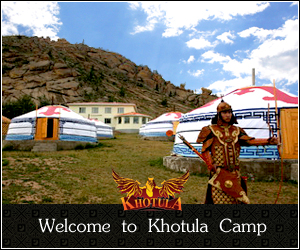Successors of Genghis Khan
In accordance with the Great Khan’s last will, the Mongol Empire was divided among his four sons. His eldest son, Zuchi, received the lands west of the Irtysh River. His second son, Tsagaadai, inherited the territory between the rivers Amudarya and Syrdarya. His third son, Ugudei, was given possession of western Mongolia and Tarbagatai. By tradition, the youngest son, Tului, obtained his father’s ancestral land.
In 1229 the Great Hurildai elected Ugudei official successor to Genghis Khan. Ugudei’s name is associated with a number of innovations in the development of the Mongol Empire. He set up a regular horse-relay post service (morin ortoo), which lasted until the mid 20th Century, to ensure prompt communication within the empire’s entire administration as well as the transportation of dignitaries.
In 1230 Ugudei sent troops to Persia that later, in 1231-1239, also invaded the Caucasus. Guided by Genghis Khan’s will, Ugudei concluded a tactical agreement with the Song dynasty of southern China on joint action against the Chin, and in 1231 he personally led a campaign to crush the Chin Empire and complete the conquest of northern China.
The fourth Khan of the Mongol Empire, Mongke (1251 -1259), also undertook two military campaigns; one headed by his brother Khubilai (founder of the Mongolian Yuan State), was intended to complete the conquest of China, and the other (aimed at invading Iran) was led by his other brother, Hulege. In 1258 Hulege took Baghdad and overthrew the Abbasid dynasty.
The wars waged by Genghis Khan’s successors resulted in the dispersal of the Mongolian tribes and a considerable reduction in the size of the Mongolian population. On the other hand, however, these wars precipitated the process of unification among various Asian and European tribes, and drew East and West nearer together, something that had never been done before.
After the defeat of the Mongolian Yuan State by the Chinese Min State in 1367, the Mongolian Khans returned from Beijing to their native territory. At this time Mongolia ceased to be the center of world trade and culture, but the Mongols retained their home territory.
Due to a crisis lasting from 1388 to 1400, various Khans replaced each other as ruler on the territory of modern Mongolia . The eastern and western Mongols’ struggle intensified from the beginning of the 15th century as a result of malevolent actions by Ming China. The strife resuited in the emergence in 1452 of the Mongol Oirad state. Some written sources described this period as the period of small Khaganates.
In the second half of the 15th century, the Mongol state was divided into east and west and then subdivided into six principalities. The six principalities included such Mongolian tribes as Khalkh, Ordos, Uriankhai, Tumd, and Yunsheby. The western Mongolian Oirads were comprised of the Mongolian tribes of Durvud, Khoshuud, Torguud and Tsoros. The period from the 17th to the early 20th century was the bleakest in Mongolian history because of the 275 years of Manchu colonial domination.












